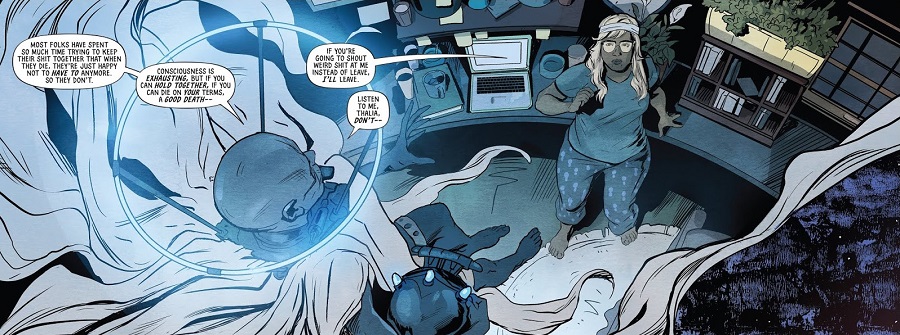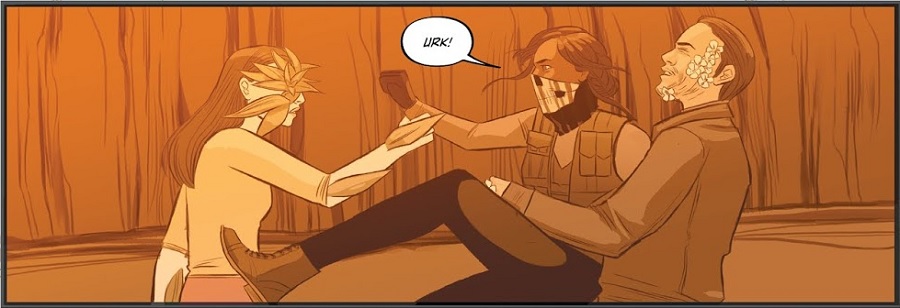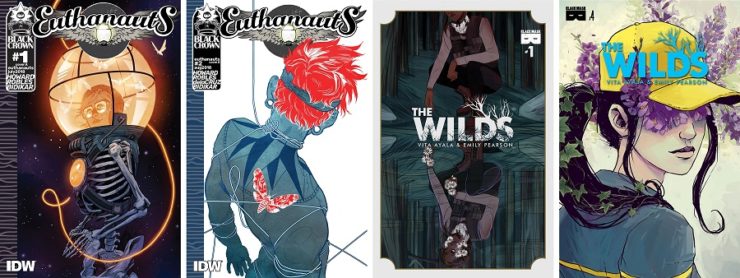When is the end is not the end? The two indie comics featured in this month’s Pull List aim to answer just that. While Euthanauts examines life after death, The Wilds travels through survival and undeath in the age of the apocalypse. Each take well-worn tropes and twist them into the unconventional, and they do it with an eye toward diversity. I hope you’ve cleared some space in your subscriptions box…
Euthanauts

When funeral director Talia Rosewood is dragged out for a night on the town with her friends, she isn’t looking forward to it. She doesn’t like her friends and she’s pretty sure they aren’t in love with her either. At a restaurant she encounters Dr. Mercy Wolfe, a woman on the precipice of death. Their lives are forcibly intertwined when before Mercy dies she nearly kills Talia. That’s when Talia learns of Death Space, Tethers, and the Euthanauts that can cross between worlds. Of the living, Mercy’s heirs bicker over her estate while her former employees scheme around Talia’s interference. Of the dead, Mercy sets her explorer’s eye on the afterlife and what happens after that.
Like The Wilds, Euthanauts posits a world where diversity is everywhere and everything—much like the real world, in fact. Characters display different body shapes, skin colors, body modifications, genders, sexual identities, etc. It’s not often you get to have a fat main character who isn’t constantly shamed for her weight or ashamed of her body. And then there’s Talia. She’s delightfully irreverent and contrarian. Whatever circumstances Tini Howard thrusts her way, Talia takes the path least expected.
On top of all that is Nick Robles’ jaw-droppingly incredible artwork. It took me ages to figure out what panel to feature for this review, they’re all so incredible. He shies away from the traditional 9-panel page and often opts for splash pages and odd layouts, both of which pair perfectly with Eva de la Cruz’s garish yet lush colors. All the better to bring the magic of Howard’s dreamscape to life. Even the lettering is spectacular. Most letterers would have a helluva time working Howard’s dense dialogue into Robles’ intricate art, but Aditya Bidikar makes it look easy.
Euthanauts is not an easy comic book. There are no simple answers or straightforward storylines. I genuinely have no clue where the story is headed. Howard’s world is so vast and unpredictable that I can’t even hazard a guess. It’s complicated and confusing, a writing mass of inexplicable scenes, effervescent dialogue, and stunning artwork. And I was agog at every single panel.
Writer: Tini Howard; art: Nick Robles; colors: Eva de la Cruz; letters Aditya Bidikar. The first issue of this monthly ongoing series was published in July 2018 by Black Crown.
The Wilds

Civilization as we know it is over, destroyed by some kind of plague that turns people into human-plant hybrid zombies. In effect, nature has taken back the world. Daisy Walker is a survivor. She works as a runner for the shady ruler of her compound. She and the other runners work off their debts by scavenging supplies out in the wild. It’s a dangerous job made worse by the ever-shifting terms of her debt. While on a run, she rescues a man from the floral Abominations, a choice that she soon regrets. She and her partner, Heather, find themselves sold as research subjects to an amoral medical group determined to find a cure at any cost. Daisy doesn’t know who to trust or how to stop the heartless scientists, but she’ll have to fight with everything she’s got.
Vita Ayala is quickly becoming one of my new favorite comics writers. They have a refreshing and compelling perspective on storytelling. It takes a bit for the story to kick in, but once it does it’s full steam ahead. The art is mostly very good. Emily Pearson is great at conversations and scenes without a lot of movement, but her action sequences are weaker. And in a comic with lots of violence and fighting, the awkwardness stands out a little too much. That being said, the way Pearson draws zombie heads exploding with the impact of a high caliber bullet is grotesque and gorgeous. Instead of going for gore and shock value, Pearson opts for stark beauty.
The coloring done by Marissa Louise and Stelladia is perfect for Ayala’s story. A lot of zombie stories lean heavily on the dark, grungy side, but Louise and Stelladia opt for bright, vivid colors as lovely as the flowers bursting from the mouths of the undead. It’s not the blood that stands out but the plant life. Jim Campbell is as solid as he always is. The lettering flows and the script reads easily. He knows how to balance out large blocks of text without it overwhelming the panel and light dialogue without it feeling sparse.
Post-apocalyptic zombie fiction has been done to, ahem, death, but Ayala breathes new life into the subgenre. The most obvious difference here is diversity. In western media, you’d hardly know queer and/or POC even exist given how few appear, even as the living dead. A few token characters here and there, usually sacrificed by the writer so as to spare the main cast and motivate the lead. Ayala takes the opposite tack and centers Q/POC as the default. I didn’t know how much a lack of diversity had dampened my fondness for post-apocalyptic stories until Ayala showed me what I was missing.
Writer: Vita Ayala; art: Emily Pearson; colors: Marissa Louise, Stelladia; letters: Jim Campbell. The first issue of this monthly ongoing series was published in February 2018 by Black Mask.
Alex Brown is a YA librarian by day, local historian by night, pop culture critic/reviewer by passion, and an ace/aro Black woman all the time. Keep up with her every move on Twitter, check out her endless barrage of cute rat pics on Instagram, or follow along with her reading adventures on her blog.










